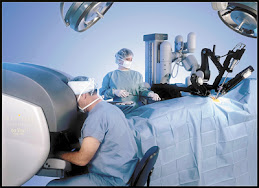http://proquest.umi.com/pqdweb?index=2&did=1325977841&SrchMode=1&sid=1&Fmt=3&VInst=PROD&VType=PQD&RQT=309&VName=PQD&TS=1195576194&clientId=7344&cfc=1
Article in Chicago Tribune
August 27th, 2007
From this article, the increasing popularity of robotic surgery not only in hospitals, but also in various medicinal fields, can be seen. While they cost about $1.5 million each, the robot systems are becoming more prevalent, and even though they have been available for only several years now, there are 504 systems in North America and 108 in Europe already. And the machines are being used to do increasingly differing procedures such as coronary bypass surgery.
On that note, an eye-catcher in this article is the segment on coronary angioplasty and the use of stents to keep arteries open, since we specifically learned about these in class. As it was mentioned in class, the article talks about how the use of drug-eluting stents is beginning to raise more and more concerns regarding their safety. Now, more and more people are opting to take the less invasive, robotics approach to bypass procedures. It’s too soon to say that robots are taking over this world, but it’s pretty amazing to see how two separate areas of biotechnology interact in something as specific as clearing up major blocked arteries.
A doctor who has just been hired by University of Chicago’s Medical Center is Dr. Sudhir Srivastava, one of the few experts on robotics surgery when it comes to the heart. While many other doctors were (understandably) too confident and “competent” to learn the skill set required for robotic bypass surgery, Srivastava has performed hundreds of heart valve repairs using the machine. This is coming from a guy who has been 20 years into practice, while the technology for robotics became available five years ago. One of the biggest cited drawbacks of robotics surgery is that it is still a new, emerging field with much research and technological improvement to undergo. But Srivastava has proven that despite that, with practice it’s possible to master something so seemingly difficult and impersonal (doctors don’t get to physically touch feel the arteries, vessels, etc. that they are working on), and it’s sure to make a lot of patients happy.
Subscribe to:
Post Comments (Atom)

1 comment:
Weight loss in a safe and permanent manner with Dr Anupam Goel, a well-known Bariatric Surgeon in Chandigarh . He has a broad knowledge of laparoscopic and robotic bariatric surgeries, and he offers advanced care based on the health requirements of every individual patient. Not only will his expertise provide good weight loss, but it will also improve associated disorders such as type 2 diabetes, high blood pressure, and arthritis. Dr. The caring nature of Goel and his obsession with the field have earned him credibility in terms of diagnosing and treating obesity.
Post a Comment